The later sixteenth century in Central and Northern Europe was a period of widespread demographic, socioeconomic, cultural, and political crisis. Two significant factors contributing to these crises were the impact of climate cooling, commonly referred to as the Little Ice Age, and the conflicts and instability associated with the religious Reformations. The Little Ice Age, which seems to have set in by the early fourteenth century, reached its height between circa 1560 and 1630.[1] A great number of these years were typified by extremely long and cold winters, much cooler springs, and very wet summers, as well as severe storms and flooding. Results of this climatic change included periodic harvest failures, famine, and also intermittent epidemics. Reformation conflicts and war exacerbated the sense of crisis, especially in France and the Netherlands, with the outbreak of the French Wars of Religion in 1562 and the Dutch revolt and its subsequent suppression by Spain in 1566–68. In such a climate of uncertainty, fear, displacement, and large-scale mortality, meteorological phenomena and natural disasters — such as floods, earthquakes, and avalanches — attained greater religious and political meaning as signs of divine assurance or punishment or of an imminent or already occurring apocalyptic End Time.
A rich source for responses to such phenomena in the later sixteenth century is the large collection of contemporary documents compiled between 1560 and 1587 by the leading member of the Zurich church and second Archdeacon in the Zurich Grossmünster, Johann Jakob Wick.[2] Wick’s collection of printed and handwritten reports, letters, broadsheets, ballads, and images, which were bound together into twenty-four manuscript volumes, provides us with a large amount of material through which to explore the different ways in which extreme and destructive natural events were perceived and deployed to strengthen historical understanding and confessional identity. A significant number of these reports and stories are concerned directly or indirectly with fire—fires created by arsonists that consume houses and public buildings, fires created by lightning or comets, fires as instruments for punishing criminals, and fires as auroras experienced as wondrous visions representing divine anger. In this essay, I aim to focus on some of the more than one thousand colored pen-and-ink drawings contained in Wick’s collection in order to explore the different understandings and emotional impact of fire in later sixteenth-century European societies.
Fire was fundamental to survival as the primary means of cooking and heating in traditional European societies. Given that most buildings in villages, towns, and cities were primarily made from wood and that wood was the main source of cooking and heating, communities had to constantly manage this most common and dangerous risk.[3] Wick’s large collection of documents with its numerous illustrations and commentaries was primarily meant to evoke wonder in its readers and viewers—to have them wonder at the awesome and terrifying times through which they were living. So it’s not surprising that the destructive impact of fire on human and animal life as well as infrastructure, whether accidental or intentional, was such a frequent concern.
While the anxiety fire evoked rested on its destructive power and the vulnerability of the environment, the fascination with fire was rooted in the uncertainty of its origins and powerful cultural associations. A report in Wick’s collection (F. 21, fols. 154r–156r), which is headed “an unheard of, yet true, wonder and sign,” describes an extraordinary event involving fire in the Swiss town of Biel/Bienne in March 1572 (figure 1).[4] On the basis of information received from various trustworthy citizens from the town and region of Biel, and most notably in a letter by the city’s pastor and dean of the parish chapter, Josua Finsler, several people (in one report more than thirty) were seen to have flames and sparks that looked like burning sulphur emanating from their necks, mouths, and noses. However, the fire did not burn them or cause any hurt or injury (Wick F. 21, fols. 154v–155v).[5] Although Wick was initially sceptical about the veracity of this occurrence, the volume of evidence convinced him that this was a sign of the Last Days, when — and here he cites 2 Peter 3:7–10 — God will come with fire to consume the earth and all it contains. By contrast, Finsler, who was also an eyewitness to this phenomenon and therefore claimed it could not have been a case of trickery or hallucination, and also rejected as superstitious the view that it had been caused by witchcraft, considered it more likely to have been caused by the strange lights and sparks created by the fatty and inflammable sulphuric exhalations of Renaissance meteorology.[6]
figure 1. Fire in the Swiss town of Biel/Bienne in March 1572, pen and ink, in Wick, F. 21, fol. 155r. Zentralbibliothek Zurich, Handschriftenabteilung.
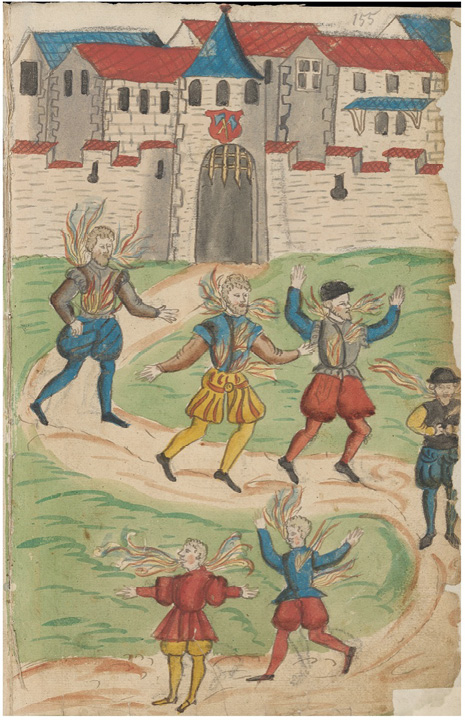
The mysterious properties of fire are also represented in many other stories. In 1568, Wick received a report of a wondrous sign involving fire that occurred in Alsace on January 6, the feast of Three Kings. As two wagon drivers from Bremgarten came to a large field, about a day’s distance from Basel, it suddenly began to rain, even though the sky was very clear. Then fire fell from heaven; and when the men crawled under their wagon out of fear, the fire followed them and singed their beards as well as harmed their horses. Moreover, the fact that the fire then turned “absolutely blood red” (ganz blutrot) certainly demonstrated that this was no less than a divine wonder, even if its precise meaning remained unclear (Wick F. 17, fols. 275r–v; Senn 157).
It is such fire that comes from the sky, or fire that appears in the sky, that features prominently in the drawings found in Wick’s collection. Lightning strikes were frequently the origin of town or village fires, but the manner in which the lightning is represented suggests a complex understanding of fire that comes from the sky. In some cases, artists simply depict lightning bolts causing fire, as we might depict such meteorological events today — as in the case of the lightning that struck a church tower in Bernhardzell in the territory of the Bishop of St. Gallen in June 1571 (Wick F. 19, fols. 243r–v; Senn 199–200) and penetrated as far as the host containers in the Sacrament House, breaking them open, scattering the hosts, and smashing the images of saints and other liturgical vessels (figure 2).[7] But frequently the lightning bolts are depicted as real fires emanating from the sky to burn up and consume human habitation on earth. This is clear in many of these illustrations, and abundantly so in a depiction of the fire that fell from heaven and consumed ten papal galleys and their men in December 1570 between Sicily and Malta (Wick F. 19, fols. 217v–218r; Senn 207) as they sought to aid the Venetian fleet in the naval battle against the Turks (figure 3). The text also does not use the common words for lightning, such as Blitz or Stral, but fhür (feuer): “a fire fell from the bright sky” (Wick F. 19, fol. 217v).[8]
figure 2. A lightning strike on a Catholic church in Bernhardzell, June 7, 1571, pen and ink, in Wick, F.19, fol. 243v. Zentralbibliothek Zurich, Handschriftenabteilung. figure 3. The destruction of papal galleys by a fire from heaven in December 1570, pen and ink, in Wick, F. 19, fol. 217v. Zentralbibliothek Zurich, Handschriftenabteilung.
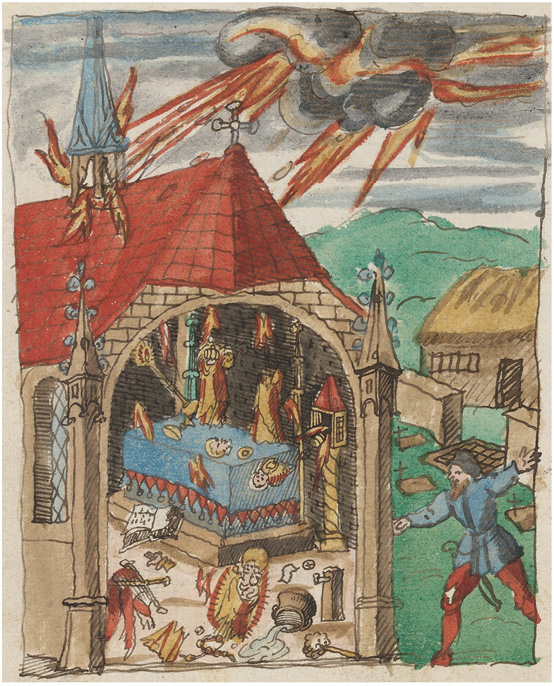
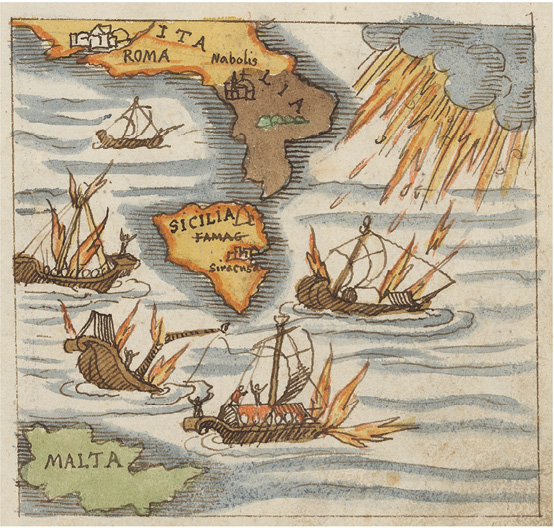
The German word for “sky,” Himmel, can refer either to the earthly sky or the supercelestial realm of the heavens. The heavenly realm as the origin of such fires is frequently depicted as above the earthly sky by means of a thick border of clouds, from which fire falls and consumes property in its path.[9] In an incident in Winterthur in May 1574 (Wick F. 23, fol. 56r), the townspeople believed that a fire was breaking out and so they ran to fetch their buckets, only to find that it was fire falling from heaven (figure 4). The artist indicates clearly that this fire originated above the clouds in the heavenly realm, for the sun is clearly located beneath them. The divine origin of such fire is sometimes even more explicit, as in the illustration of the “fire from heaven” that fell on the city of Zurich on February 18, 1584 (figure 5). Here God the Father sits above the clouds, holding his orb as ruler of the world, and casts down fire on the city below, while one of his subjects pleads with him and the other shields his eyes from the terrible scene around him.
figure 4. The fire that fell from heaven in Winterthur in May 1574, pen and ink, in Wick, F. 23, fol. 56r. Zentralbibliothek Zurich, Handschriftenabteilung. figure 5. The fire that fell from heaven on Zurich, February 18, 1584, pen and ink, in Wick, F. 32, fol. 19v. Zentralbibliothek Zurich, Handschriftenabteilung.

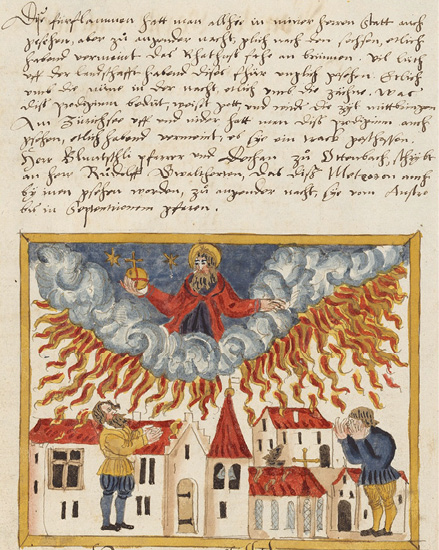
In Christian belief and representation, fire is strongly linked to punishment — whether punishment by the fires of hell or purgatory in the next life or punishment for especially heinous crimes on earth. Witches, heretics, sodomites, poisoners, forgers, and arsonists all suffered punishment by fire, a demonstration not only of the horrendous nature of their crimes against the physical, moral, and spiritual order within society but also of fire as a radical cleansing agent that was meant to remove all trace of evil perpetrators from the earth.[10] In the case of witches, such as a witch who destroyed all but three houses in the southwest German town of Schiltach by following the instructions of the Devil to upturn a magical cauldron he had given her, several of these crimes came together (figure 6).[11] Fire was also an instrument of divine punishment for sin in the Bible, the archetypal case being that of the destruction of Sodom, which was frequently depicted undergoing total annihilation by fire, a catastrophe that originated in the heavens (Gen. 19:24–25). In some of these cases, the destructive fires represented the outward form of God’s blazing fury at human sin, as in the biblical story of God’s anger that blazed out against the complaints of the Israelites in the desert and burned down part of their camp (Num. 11:1–3).
figure 6. The burning of a witch in 1533 for her arson in Schiltach, pen and ink, in Wick Sammlung, F. 13, fol. 66r. Zentralbibliothek Zurich, Handschriftenabteilung.
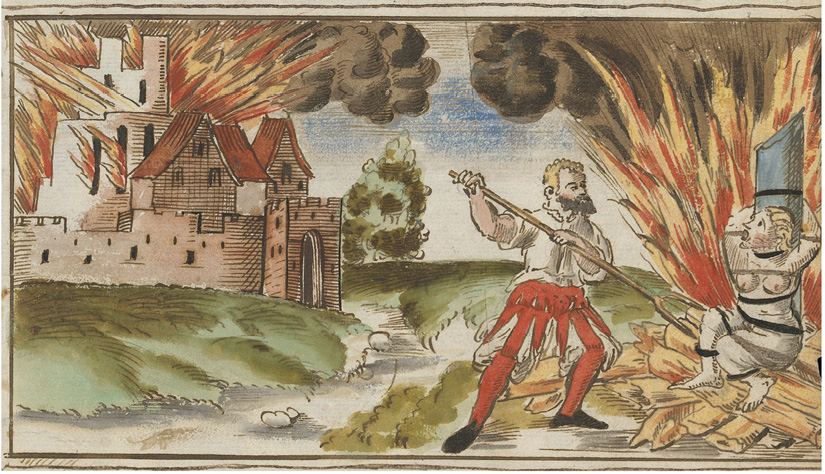
There are certainly many instances of fire in Wick’s collection where events are simply recorded and not given special meaning, or the question of their meaning is simply posed, and no answer is forthcoming. Yet some fires are clearly described as cases of God’s punishment for human sin, while others are interpreted more specifically as warnings of greater disasters to come, and even as signs of the ultimate conflagration that will occur in the Last Days. In addition to the Book of Revelation, with its references to the devastating fires and lightning thrown down from the divine throne onto the earth,[12] key apocalyptic texts that are drawn on include: Luke 17, which tells of the fire and brimstone that God will rain on the earth in the Last Days; Isaiah 66, which refers to the Lord coming with fire to give expression to his anger with fury; and 2 Peter 3 (as we have already seen), in which all the elements on the earth will melt and the world will be cleansed with fire.
These apocalyptic texts were frequently applied to the “fiery heavens,” the auroras or northern lights that were seen in the skies over Central Europe on numerous occasions between 1560 and 1587. Of considerable significance in understanding the widespread fearful reaction to these natural events is the fact that they were experienced as very new phenomena that had appeared extremely rarely in the centuries beforehand. In the three decades of the later sixteenth century, however, we know of approximately one hundred days when the northern lights were seen in North and Central Europe. The Wick volumes record sixty such cases that seem to exhibit the same characteristics, and of these at least twenty-six can definitely be classed as appearances of the northern lights (Schwarte 45–51, 180–84).[13] Indeed, the sighting of the northern lights above Zurich on the Feast of the Holy Innocents on December 28, 1560, constituted one of the three critical events of 1559–60 that Wick claimed had stimulated him to begin to put together his archive of documents illustrating the “miserable times” in which he was living (Wick F. 12, fol. 1r).[14]
A striking example of the understanding of the northern lights as heavenly fires is a broadsheet depicting the Holy Innocents aurora seen over the village of Eggolsheim near Forchheim in Franconia in 1560 (Harms and Schilling 219; figure 7). The woodcut shows huge red and orange flames of fire falling from beyond the clouds onto the village below, and the text narrates how these “large, broad and long flames of fire” caused many to think the village was on fire, so they rang the storm bell — which one can see being rung in the bell tower. Below, the upraised arms of the residents demonstrate their consternation, whereas the pointing finger of the figure dressed in the garb of the learned seems to be interpreting the event. The second half of the text below provides such an interpretation of this “terrible and terrifying wondrous sign,” based, as it claims, on arguments that can partly be discerned in Scripture: God has pity and does not wish to punish; he therefore warns the godless through signs so they might repent; and in this way, the god fearing will be more diligent in avoiding sin and the devil’s cunning and not be cast out with the godless. The text concludes with a reference to Jeremiah 18:7–8: “On occasion I decree for some nation, for some kingdom, that I will tear up, knock down, destroy; but if this nation, against which I have pronounced sentence, abandons its wickedness, I then change my mind about the evil which I had intended to inflict on it.”[15] Clearly, the fire from heaven constitutes a warning of the terrible punishment and destructive evil that God will let fall on the godless if they do not repent.
figure 7. A terrible and terrifying wondrous sign that appeared on December 28, 1560 over the village of Eggolsheim . . . , coloured broadsheet woodcut, Nuremberg: Georg Merckel, 1561. Zentralbibliothek Zurich, Graphische Sammlung und Fotoarchiv, PAS II 1/16.
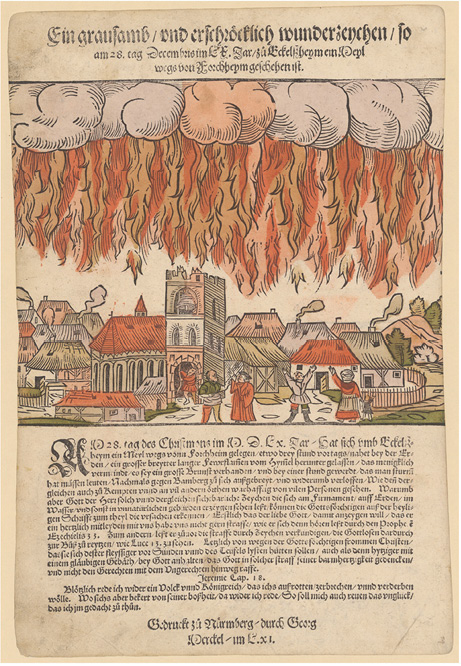
The 1560 Holy Innocents aurora is very prominent in Wick’s collection, given the crucial role it played in his own intellectual and religious biography. Seventeen different texts describe its occurrence in different parts of Europe (Schwarte 86, n. 402; 180–81; 86–96), five of which are also illustrated.[16] The fiery signs displayed, bloodred in their color both in image and text, are directed at stimulating fear and penitence in their viewers and consistently make either indirect allusions or explicit references to the shedding of blood through violence. Of the twenty-one broadsheet woodcuts illustrating the northern lights, nine include military figures, usually brandishing swords or lances (Schwarte 159–79), and some of these combine these intimations of violence with the power and destructiveness of fire.
A Nuremberg broadsheet woodcut depicting the Holy Innocents aurora seen above the town of Bamberg in 1560. for instance (figure 8; Harms and Schilling 220–21; Schwarte 161),[17] features warriors with flaming swords and military banners, lined up in opposition to each other against a backdrop of blood-stained clouds, red stars, and spears of white light emanating from two clouds to create a cross-like pattern; meanwhile the text refers to the terrifying roar and clang that could be heard as if two armies were contending against each other. Below, the inhabitants of Bamberg, clearly identifiable by its famous cathedral on the left perimeter, mass in horror on the bridge over the Regnitz, which links the city’s old commercial center with the ecclesiastical precinct. They are crushed together to such an extent (the text tells the reader) that they feared the bridge would give way. One figure in the crowd and two travelers shown outside the city (who are specifically referenced in the text) point up at the sky — a common visual technique emphasizing the need for contemporary eyewitnesses (and also later readers) to interpret such heavenly signs. The author of the accompanying text in this case, however, leaves the interpretation open, claiming that only God knows. But he also assures readers that God wishes to protect church and community from all evil and shows mercy in order that all might repent of their sins. The meaning of the visual message, however, is somewhat different, for the violence of wars waged in the heavens is often explicitly associated with the exaction of divine vengeance and the destruction of the End Time.
figure 8. A very frightening apparition and wondrous sign that appeared over Bamberg and Lichtenfels on 28 December 1560, coloured broadsheet woodcut, Nuremberg: Georg Kreydlein, 1561. Zentralbibliothek Zurich, Graphische Sammlung und Fotoarchiv, PAS II, 1/17.
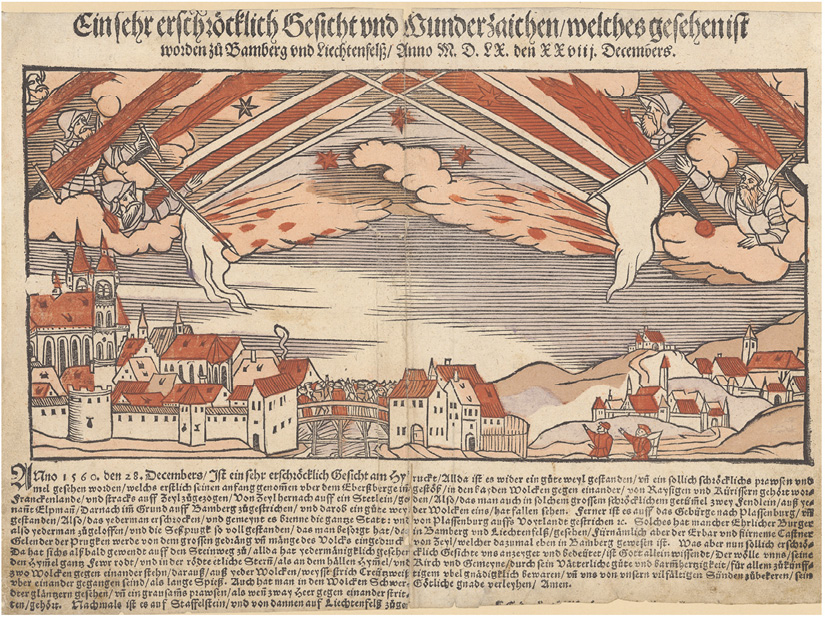
A graphic example of such a reading by Wick is his response to the literary account of the 1560 Holy Innocents aurora seen by Hieronymus Opiz, the Lutheran pastor and superintendent in Bishoffswerda, Saxony (Wick F. 12, fols. 135v–136r).[18] As was the case at other locations such as Eggolsheim, when the aurora first appeared, everyone thought the whole town was on fire. People ran into the streets in panic, shouting, ringing the fire bell, and gathering buckets. The apparitions in the sky took the form of bloody, fire-red streamers stretching almost down to the earth. Opiz suggests that fiery signs in the heavens are certainly premonitions of the Last Day—on which all the elements will melt and the world will be cleansed by fire. But Wick’s commentary takes the interpretation further: “Fiery apparitions often signify God’s anger and punishment with the sword,” he writes, “the shedding of blood and devastation of lands” (F. 12, fol. 136r ),[19] and the direction in which they move refers to the territories and peoples God’s anger will strike. Wick then inserts three crucial biblical references to make it abundantly clear that he understands this event as a premonition of the Last Days: Isaiah 66:15–16, which refers to the Lord coming to assuage his anger with fire and his threats with flaming fire; Matthew 25:41, in which the wicked are cursed and damned to eternal fire; and 2 Peter 3:7–12, which tells of the Day of Judgment, when the earth and all that it contains will be burned up, the sky will dissolve in flames, and the elements will all melt. Finally, Wick returns to the metaphor of a town fire but applies it to the furious fire of divine anger: “We need to go out with buckets and tubs and scoop out the water from our eyes, weep for the sins in our heart, do true repentance, so as to extinguish God’s angry fire with our prayers” (F. 12, fol. 136r).[20]
Earthly fires were also sometimes interpreted as signs of the Last Times on the basis of apparitions in the sky. This is quite explicit in a drawing in Wick’s collection of a fire that broke out in the Palatinate in November 1586, when a fiery dragon appeared in the sky at the same time (figure 9). The pen-and-ink drawing accompanies an account of the event by the Schaffhausen theologian and preacher Johann Conrad Ulmer.[21] Ulmer writes in a letter to Wick that a frightening fiery sign, which was either a flying dragon or burning torch, was seen in the sky together with a lightning flash near a small town called Höst, in the bishopric of Mainz, where it struck the granary of the Duke of Parma and burned the building and its contents to a powder (Wick F. 35, fol. 20r–v; Schwarte 144). The prodigious sign in the sky was clearly an aurora, which was seen in many locations through Switzerland, such as in Bremgarten, Baden, Mulhouse, and Zurzach.[22] It was considered wholly unnatural, since it appeared like the bright sheet lightning that one experiences in summer, rather than in the cold of winter. To some it appeared as fire falling from the sky, as a fiery oven, or as a long streamer like a lance falling from a star, constantly changing in size, shape, and luminosity like a burning house. To Wick, however, it was a frightening sign of God’s anger (Wick F. 34, fol. 307r; Schwarte 142).[23]
figure 9. A prodigious and wondrous sign of a fiery dragon that appeared in the sky when a fire broke out in the Palatinate in November 1586, pen and ink, in Wick Sammlung, F.35, fol. 20v. Zentralbibliothek Zurich, Handschriftenabteilung.
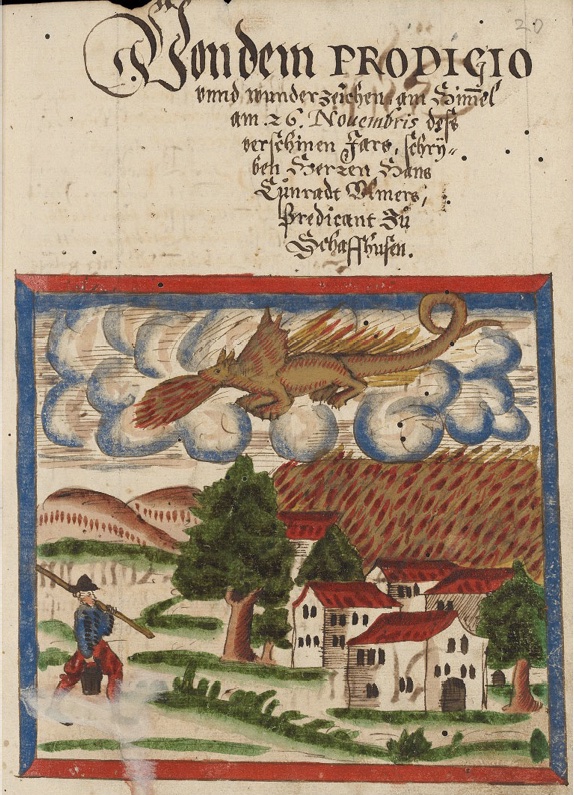
This meaning of the event was taken up in a ballad of thirteen verses composed to commemorate it (Wick F. 34, fols. 308r–309v; Schwarte 143–44). The flying dragon was described as a heavenly flaming torch streaming to earth, its tail taking on the appearance of a rod to punish those who hate God’s word. The ballad assured listeners that this was a rod that God had often used to punish those who refused to repent. Even the timing was critical. A sign like this on the eve of Advent, the ballad claimed, referred to Christ’s imminent coming, when he would unite his kingdom, raise up his poor children from their fear and pain, and close the mouth of the devil and his followers. The fiery dragon in the sky was clearly understood, by some at least, as a sign not only of God’s anger and punishment but also of hope of liberation from pain in this End Time.
While the most commonly described reactions to these catastrophic and portentous events were apprehension and fear, and at other times panic, the recommended response in some pamphlets is more restrained and resourceful. It combines practical action with emotions considered appropriate to what were deemed the deeper spiritual and cosmic meanings of such events. An illuminating example is the case of the lightning strike of May 7, 1572 (Wick F. 21, fols. 140r–142r) that struck the bell tower of the Grossmünster, the Zurich cathedral at which Wick served as Second Archdeacon, the second most important official in the Swiss Reformed Church (figure 10). That Wick had an artist illustrate this event with a large double-page drawing suggests the importance of the event in the life of this Reformed city at a critical period in the struggle between Catholics and Reformers in the Netherlands and France. The detailed drawing closely follows the “official” account of the fire by the First Archdeacon and leading reformer Heinrich Bullinger — located immediately before it in Wick’s collection — and also seems to give expression to the key meanings that Bullinger extracts from this event and its aftermath.[24] Bullinger firstly praises the courage and united determination of the citizens in not allowing the second tower, the church roofs below, and the surrounding buildings to catch fire. But he also stresses God’s mercy on a number of occasions in the report. God ensured that the fire burned at only a moderate rate, he produced a fierce downpour to extinguish the flames at a critical moment, and he protected those on the ground from the dangers of falling objects, including any potential disaster that might have resulted if the bells were to fall. It is clearly the community’s energy and unified action that diminish God’s anger; and this is celebrated with a number of documents that follow, listing the names of the citizens most prominent in leading this response. Yet another sign of God’s wondrous mercy, Bullinger claims, is that despite the severe destruction brought about by God’s anger at the failings of the Zurich community, the debris was cleaned up on the following day, with the result that after only one day, the community could gather once again for the daily sermon and communal prayer.
figure 10. The citizens of Zurich attempt to put out the fire in the Grossmünster, following a lightning strike on May 7, 1572, pen and ink, in Wick Sammlung, F. 21, fols. 142v–143r. Zentralbibliothek Zurich, Handschriftenabteilung.

The drawing of the fire emphasizes the concerted and unified action of the Zurich citizenry. Some try to climb up as high as possible in the burning bell tower (clearly identified by the twelfth-century equestrian relief with a red rider just below the first gallery arcade) to douse the fire in the spire; others — identified as the current watchmen Victor Zevetz and Sebastian Sturm — punch holes in the second tower (called the Charlemagne tower) and pour water and manure on the tiles below to prevent the fire from spreading.[25] Those on the roof of the nave and of the galleries above the north aisle watch out for burning debris falling from the spire, using their water buckets to douse any burning objects that might cause the whole cathedral to catch fire. Meanwhile, their companions below retrieve the empty buckets thrown to the ground, have them refilled by both men and women (as a figure depicted in the north portal indicates), and then mount ladders to deliver the filled buckets to those on the roof.[26] One large water container is even topped up by a figure urinating from the bell tower. An intriguing inclusion, not found in Bullinger’s description but in an additional document in Wick’s collection under the heading “A wondrous sign in the sun during the fire,” is the setting sun in the top left corner of the illustration. At seven in the evening, the sun was said to appear red and bloody in color and caused more fright than the fire itself (F. 21, fol. 142r).
As I have argued above, the appearance of bloodred signs or apparitions in the sky refers to the shedding of blood that was to occur as a result of God’s vengeance or punishment or, more directly, of the fires that would accompany the destruction of the Last Days. In this instance, the appearance of a bloodred sun seems to represent a fear that mirrored Bullinger’s own feelings, despite his emphasis, in a letter of May 9, two days after the lightning strike, on the mercy God displayed toward the Zurich citizens in this terrible act of warning. One week later on May 16, in a letter to Tobias Egli, a pastor in the city of Chur, Bullinger wrote that while acknowledging the great mercy God had shown, we should pray to the Lord that this sign is not a portent of greater evil to come. He then adds, “So great is the depravity of all in the Swiss Confederation. I fear, I fear, [he repeats] it is not far from the End and from the Day of Vengeance” (Mauelshagen 134, n. 32).[27] Bullinger knows that the fire of God’s anger is a constant, ongoing threat and that each fire marks the outpouring of divine anger, an anger that needs to be constantly assuaged. In the illustration to the set of documents reporting on this key event in the history of the Swiss Reform and, by extension, of Reformed Protestantism in general, the artist’s depiction of the blood-red sun emitting its powerful rays seems to have picked up on the ominous character of this fire: a warning sign of God’s anger certainly but also a portent of future destruction and of the punishments and disasters of the Last Days. Wick’s locating of the Zurich events within a series of references to other lightning strikes and fires throughout Europe at this approximate time suggests that he also viewed the event in this broader cosmic context.[28]
Fire was indeed an ever-present danger in the towns and villages of sixteenth-century Europe, as Johann Jakob Wick’s large collection of contemporary documentation strongly suggests.[29] But rather than simply a danger, fire possessed a mysterious, magical, and also symbolic character, largely because its activity was unpredictable and its origins unclear. This was especially so since many fires were caused by lightning strikes that had their origins in the sky, a realm little understood and closely associated with supernatural and divine forces. Given the close practical association of fire with punishment, and its symbolic association with bloodshed and violent destruction, fires with unknown perpetrators or fires that seemed to fall mysteriously from the sky were understood as acts of divine anger in retribution for human sin, or at least portents and warnings of greater destruction if sin persisted in the future. At times of significant social and religious anxiety and crisis, as in the second half of the sixteenth century when Reformation battles became more strident and violent and the very survival of the Reformation appeared in doubt, fires were also linked to apocalyptic fears and expectation and read as signs and portents of the Last Days. Such connections were further exacerbated by the appearance of previously unknown bloodred auroras and other strange meteorological phenomena produced as a result of the climatic changes from the 1560s, generally referred to as the Little Ice Age.
Some might view such responses to fire as sophisticated techniques of displacement, as instruments for turning a blind eye to the chaotic destruction and intense fear and anxiety that fire produces. But that would be to ignore the complex cultural reality, symbolic meanings, and intense individual and group emotions that fire has generated through its history. Moreover, there is little indication in the mass of documentation in the Wick collection that fire promoted a fatalistic resignation toward its destructive power. To the contrary, the different beliefs associated with the nature of fire frequently generated responses and strategies that endeavored to make sense of its destructive power, that helped to focus the physical and emotional energy and concerted action of those attempting to control it, and that even provided a basis for sustaining and rebuilding community once the danger had passed.
Thanks to Julie Davies for assistance in procuring the images for this chapter. Research was supported by the Australian Research Council Centre of Excellence for the History of Emotions (project number CE110001011).
endnotes
-
For more on the Little Ice Age and related crises, see Brian Fagan, The Little Ice Age: The Prelude to Global Warming 1300–1850 (New York: Basic Books, 2000); Wolfgang Behringer, A Cultural History of Climate, trans. Patrick Camiller (Cambridge, UK: Polity, 2010), 85–167; Wolfgang Behringer, “Weather, Hunger and Fear: The Origins of the European Witch Persecution in Climate, Society and Mentality,” German History 13, no. 1 (1995): 1–27; Elaine Fulton and Penny Roberts, “The Wrath of God: Explanations of Crisis and Natural Disaster in Pre-Modern Europe,” in History at the End of the World? History, Climate Change and the Possibility of Closure, ed. Mark Levene, Rob Johnson, and Penny Roberts (Humanities-EBooks, 2010), 67–79; Elaine Fulton, “Acts of God: The Confessionalisation of Disaster in Reformation Europe,” in Historical Disasters in Context: Science, Religion, and Politics, ed. Andrea Janku, Gerrit Schenk, and Franz Mauelshagen (New York: Routledge, 2012), 54–74; Christian Pfister and Rudolf Brazdil, “Climatic Variability in Sixteenth-Century Europe and Its Social Dimension: A Synthesis,” Climatic Change 43, no. 1 (1999): 5–53, Special Issue; and Christian Pfister, “Climatic Extremes, Recurrent Crises and Witch Hunts: Strategies of European Societies in Coping with Exogenous Shocks in the Late Sixteenth and Early Seventeenth Centuries,” The Medieval History Journal 10, nos. 1–2 (2007): 33–73. ↩
-
On Wick and his collection, see Franz Mauelshagen, Wunderkammer auf Papier: Die Wickiana zwischen Reformation und Volksglaube (Epfendorf: Bibliotheca Academica Verlag, 2008) and the works cited in Charles Zika, “Visual Signs of Imminent Disaster in the Sixteenth-Century Zurich Archive of Johann Jakob Wick,” in Disaster as Image: Iconographies and Media Strategies across Europe and Asia, ed. Monica Juneja and Gerrit Jasper Schenck (Regensburg, Germany: Schnell und Steiner, 2014), 43–53, at 43, note 1. The manuscript collection of twenty-four folio volumes averaging six hundred pages each is held in the Zurich Zentralbibiothek under the title: Johann Jakob Wick, “Sammlung von Nachrichten zur Zeitgeschichte aus den Jahren 1560–87” with signature numbers F. 12–19, 21–29, 29a, 30–35. ↩
-
For the frequency, impact, management, and fear of fires, see Penny Roberts, “Agencies Human and Divine: Fire in French cities, 1520–1720,” in Fear in Early Modern Society, ed. G. Naphy and Penny Roberts (Manchester, UK: Manchester University Press, 1997), 9–27. For information on fire as the second most commonly reported catastrophe (after war) in Swiss illustrated chronicles of the fifteenth and sixteenth centuries, see Daniela Schulte, Die zerstörte Stadt: Katastrophen in den schweizerischen Bilderchroniken des 15. Und 16. Jahrhunderts (Zurich: Chronos, 2020), 124–25, and the many local examples and illustrations throughout the book. For more on the fear of arson, its deployment in feuds and extortion, and its frequent association with vagrants, confessional enemies, and foreign powers, see Robert Scribner, “The Mordbrenner Fear in Sixteenth-Century Germany: Political Paranoia for the Revenge of the Outcast,” in The German Underworld: Deviants and Outcasts in German History, ed. Richard J. Evans (New York: Routledge, 1988), 29–56; Penny Roberts, “Arson, Conspiracy and Rumour in Early Modern Europe,” Continuity and Change 12, no. 1 (1997): 9–29; Roberts, “Agencies Human and Divine,” 22–24; and Joel F. Harrington, The Faithful Executioner: Life and Death, Honor and Shame in the Turbulent Sixteenth Century (New York: Farrar, Straus, and Giroux, 2013), 10–12, 126, 207. ↩
-
“1572. Von einem unerhörtem, doch warhafftem wunder und zeichen, welches an ettlichen fürnemmen personen zü Biel gesähen, wie fhürflammen und gneist von innen ussgangen, und doch das fhür sy nütt gebrent, und kein sonderen schmerzen darduch empfangen.” In this essay, I cannot consider the range of fascinating questions concerning the new visualization of city fires in early modern Europe; see Cornel Zwierlein, Der gezähmte Prometheus: Feuer und Sicherheit zwischen Früher Neuzeit und Moderne (Göttingen, Germany: Vandenhoeck & Ruprecht, 2011), 136–55; Nancy Corwin, “The Fire Landscape: Its Sources and Its Development from Bosch through Jan Brueghel I with Special Emphasis on the Mid-Sixteenth-Century Bosch ‘Revival’” (dissertation, University of Washington, 1976); Vera Koppenleitner, Hole Rößler, and Michael Thimann, eds., Urbs incensa: Ästhetische Transformationen der brennenden Stadt in der Frühen Neuzeit (Munich: Deutscher Kunstverlag, 2011). ↩
-
Also see Hans Rudolf Lavater-Briner, “Teufelsspuk und Feuerflammen: Pfarrer Josua Finsler (1525–1602) über Unglaubliches aus Biel und Umgebung,” Zwingliana 40 (2013): 127–41. ↩
-
For references in meteorological works to Finsler’s explanation of the phenomenon as one of “ignis fatuus et lambens,” see Lavater-Briner, “Teufelsspuk und Feuerflammen,” 138–40. Finsler’s letter was addressed to the Zurich pastor Burkhard Leemann, and the Wick version is known to be a faithful copy on the basis of another copy found in the Zurich archive. For the broader context of contemporary meteorology, see Craig Martin, Renaissance Meteorology: Pomponazzi to Descartes (Baltimore: Johns Hopkins University Press, 2011), 80–105. ↩
-
This was clearly understood as a divine judgement on the Catholic territory of St. Gallen. ↩
-
“… als sy nütt wyt von einem port, zwüschet Malta und Sicilia gefaren, ist von heyterem himel ein fhür uff die galeen gefallen …” (underscore in the original). ↩
-
See Wick F. 29, fol. 70v for the fire that fell on the female convent of Riederen in the Black Forest on September 4, 1580, and consumed three barns. ↩
-
Richard van Dülmen, Theatre of Horror: Crime and Punishment in Early Modern Germany, trans. Elisabeth Neu (Cambridge, UK: Polity, 1990), 91–92; Roberts, “Arson, Conspiracy and Rumour,” 16. ↩
-
The drawing was based on a broadsheet woodcut published by Stefan Hamer in Nuremberg in 1533. See Charles Zika, The Appearance of Witchcraft: Print and Visual Culture in Sixteenth-Century Europe (Oxford, UK: Routledge, 2007), 182–83, fig. 7.2. ↩
-
Rev. 4:5; 8:2, 5–10; 9:17–18; 11:5, 19; 14:10; 16:8–9; 18. ↩
-
For a general history of the northern lights, see Wiebke Schwarte, Nordlichter: Ihre Darstellung in der Wickiana (Münster: Waxmann, 1999), 36–45; Hermann Fritz, Verzeichnis beobachteter Polarlichter (Vienna, 1883); R. H. Eather, Majestic Lights: The Aurora in Science, History, and the Arts (Washington, DC: American Geophysical Union, 1980); Asgeir Brekke and Alv Egeland, The Northern Lights: Their Heritage and Science (Oslo: Grøndahl Dreyer, 1994). ↩
-
“Dise bücher ein anderen nach begryffend vilerley historien, und insonders diewyl sic uff den fhürigen himel im 1560 iar an der unschuldigen kindlin tag mancherlein gshichten zuo getragen … Unnd so der laser die flyssig besicht, so wirdt er sich grösslich verwunnderen ab der trübseligen zyth.” Although this statement is found on the title page of the first volume of 1560, it was written and inserted seventeen years later in 1577. ↩
-
The translation is that of the Jerusalem Bible. The broadsheet quotes the Luther Bible, which is much more powerful in its language than the King James Version or Jerusalem Bible: “Blötzlich rede ich wider ein Volck unnd Königreich/das ichs ausrotten/zerbrechen/unnd verderben wölle. Wo sichs aber bekert von seiner boßheit/da wider ich rede/So soll mich auch reuen das ungluck/das ich im gedacht zü thün.” ↩
-
One of these is a pen drawing, depicting the vision in the sky above Vienna, of a man in armor, shaking a fiery sword (Wick F. 12, fol. 80r; Zika, “Visual Signs,” 48–49, 220, colored plate 5); the others are broadsheet woodcuts, reproduced in Wolfgang Harms and Michael Schilling, eds., Deutsche illustrierte Flugblätter des 16. und 17. Jahrhunderts, vol. 7, Die Sammlung der Zentralbibliothek Zürich. Kommentierte Ausgabe Teil 2: Die Wickiana II (1570–1588) (Tübingen: Max Niemeyer Verlag, 1997), 216–21; Schwarte, Nordlichter, 159–61; and in color in Zika, “Visual Signs,” 217, plate 2, and figures 7 and 8 in this essay. ↩
-
The broadsheet originally followed the man in armor seen in Vienna, in Wick F. 12, fol. 80r (see the previous note). ↩
-
See also Matthias Senn, ed., Die Wickiana: Johann Jakob Wicks Nachrichtensammlung aus dem 16. Jahrhundert (Basel: Raggi, 1975), 58–59, and Schwarte, Nordlichter, 119–20. This is based on a printed pamphlet by Hieronymys Opiz: “Von dem erschrecklichen vnnd grossen fewrigen zeichen, welches am himel am tag der unschuldigen Kindlein, im Jar nach der geburt Christi, MD LXI. …” (Nuremberg: Valentin Neuber, 1561), reader.digitale-sammlungen.de/de/fs1/object/display/bsb10203608_00005.html. For a more detailed account of this text, see Charles Zika, “Disaster and Apocalypse, Emotions and Time in Sixteenth-Century Pamphlets,” in Disaster, Death and the Emotions in the Shadow of the Apocalypse, 1400–1700, ed. Jennifer Spinks and Charles Zika (London: Palgrave Macmillan, 2016), 69–90. ↩
-
“Fhürige gsichten bedütend offt Gottes zorn und straff, mit schwert, bluot ververgiessen, verhergun der lande.” ↩
-
“Wir möchtind wol mit fhüreymmeren und wasserküblen zuolauffen und das wasser uss unseren augen darin schöpfen, über unsere sünd herzlich weynen, ware buoss thuon und Gottes zornig fhür mit batten uslöschen, darzuo wer es an der zyt.” This whole sentence is underlined in the original. ↩
-
For more on Ulmer, a critical figure in the dissemination of information in Central Europe, see Endre Zsindeley, “Johann Conrad Ulmer,” in Schaffhauser Beiträge zur Geschichte Biographien, part 4, (Schaffhausen: 1981), 358–69, and Mauelshagen, Wunderkammer auf Papier, 130. ↩
-
For this and the quote in the following note, see the texts extracted from Wick F. 34 and F. 35 in Schwarte, Nordlichter, 141–45. ↩
-
“… und guot das wir ab dyßeund andern erschrockenlichen zeichen gotes zorn lerntind erkennen ….” ↩
-
Bullinger’s account, referred to as a “bsondere gschrift” in his diary (Heinrich Bullingers Diarium, 109), was a letter to the Schaffhausen pastor Conrad Ulmer, dated May 9, 1572. The concluding sentence makes clear it was meant to provide a correct interpretation of the fire. See Heinrich Bullinger, Heinrich Bullingers Diarium (Annales Vitae) der Jahre 1504–1574, ed. Emil Egli (Loßburg, Germany: Theologische Buchhandlung, 1904). The version in Wick (F. 21, fol. 141r–142r) differs slightly from the original. For a transcription of the original and an extended discussion of the event, see Mauelshagen, Wunderkammer auf Papier, 127–43. ↩
-
For the structure and history of the Zurich Grossmünster, see Daniel Gutscher, Das Grossmünster in Zürich: Eine baugeschichtliche Monographie (Bern: Gesellschaft für Schweizerische Kunstgeschichte, 1983). ↩
-
The depiction of a fire in Bern on July 14, 1575 (Wick F. 24, fol. 290v) also shows women carrying large pails filled with water on their heads and emptying them into a much larger container on the ground, from which the men replenish their buckets and climb the ladders. ↩
-
“Tanta est omnium per Helvetiam consceleratio. Ich fürcht, ich fürcht, es sye nitt wyt som end und von der vergältung.” ↩
-
Similar events are cited at about this time in Rosheim near Strasbourg, Colmar, Schwyz, Fribourg (Wick F. 21, fol. 145v), Constance (fol. 149r), Rome, Würzburg, Venice, and Leipzig (fol. 150r). ↩
-
For the frequency and size of fires in early modern Europe, before they began to decrease around 1700, see Zwierlein, Der gezähmte Prometheus, 73–120, and various essays in Martin Körner, Nikolaus Bartlome, and Erika Flückiger, eds., Stadtzerstörung und Wiederaufbau: Zerstörungen durch Erdbeben, Feuer und Wasser, vol. 1 (Bern: Paul Haupt, 1999). ↩


